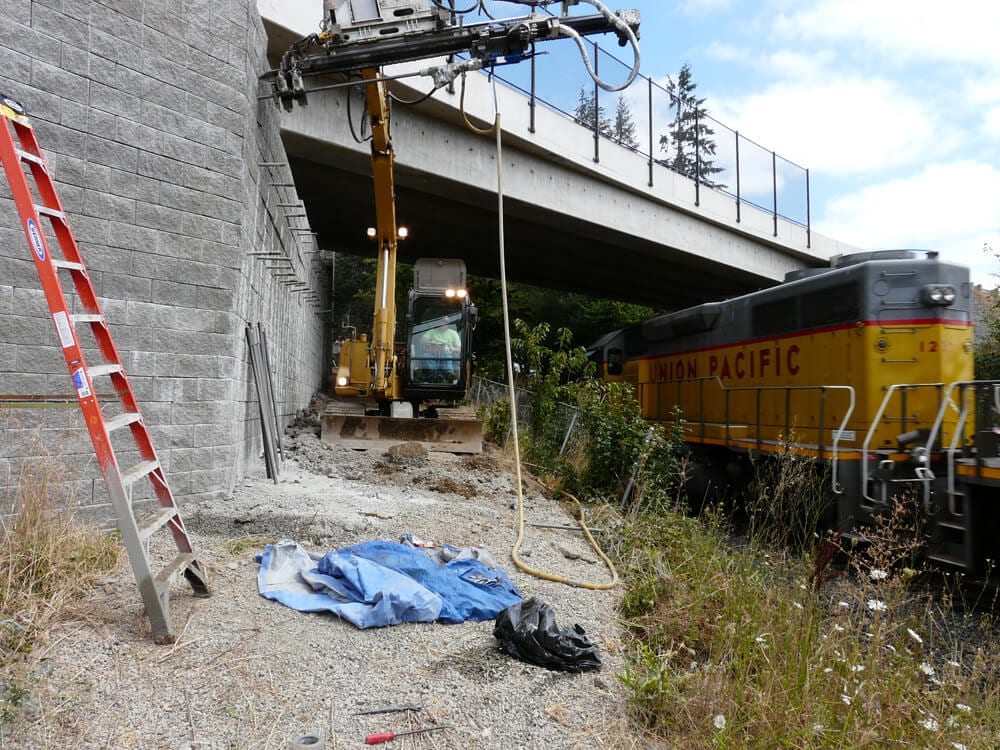



Railway bridge abutments usually consist of a rock basket retaining wall, retaining wall mesh, soil nailing, or traditional Mechanically Stabilized Earth, otherwise referred to as MSE wall. Improper installation, age, and climate change can all affect the performance of these walls, necessitating MSE retaining wall repair to preserve the structural stability of all the railway bridge components.
Minor uniform settlements usually present little concern. However, differential settlements are often the source of serious structural problems. MSE walls, introduced several decades ago, prove superior to traditional reinforced concrete walls because they can withstand differential settlements without serious structural distress. Still, with MSE bridge abutments, every case of settlement calls for close, careful examination on a case-by-case basis to determine the settlement’s effect on the superstructure and the necessary intervention and repair.
At GeoStabilization International®, we are one of the nation’s leading retaining wall repair, restoration, and rehabilitation specialists. You can trust our geotechnical engineers and masons to stabilize any railway bridge abutments.
An MSE wall may fail for many reasons, including:
Railway abutments, in particular, are subject to high stress levels and require care and precision during the design and construction phases. Any mistakes will quickly become serious concerns, resulting in the need for expert repair of the retaining wall.
MSE wall repairs of railway abutments present several unusual challenges that most inexperienced stabilization or soil nail wall contractors are unprepared to face. Only experienced contractors like GeoStabilization International® have the experience and equipment to work under these projects’ constraints.
Bridges, especially those still in operation, present severe access challenges. For instance, working on steel girders and concrete decks requires the installation of a custom swing stage scaffolding, while working on abutments usually requires construction in a very constrained area.
In general, retaining wall repair requires the demolition of the existing facing while stabilizing the backfill and supports. However, this process is dangerous, disruptive, and lengthy, which is why many MSE wall repair contractors have moved to in-situ retainer wall repair. This method tends to be more affordable and faster and causes less disruption to existing structures, such as roads or railway tracks.
Railroad geohazard mitigation is a serious operation that our team can handle. In this memorable example, concrete facing blocks of a railroad bridge abutment were bowing outward due to inadequate horizontal reinforcement during initial construction. Our team at GeoStabilization International® was called to provide additional reinforcement in the top three feet of the bridge abutments within the right-of-way for the main rail line. The existing abutment had to remain in place, work could not interfere with train traffic, and our crews were restricted to the 12-foot-wide work zone adjacent to each abutment.
Our engineers worked with a general contractor, county personnel, and the county’s consultants to develop the reinforcement loads, determine soil nail locations, and obtain necessary permits. Our GeoStabilization crews assembled special equipment to install and load-test two rows of 20-foot Self-Drilling SuperNails™ in the north abutment and one row of 12-foot Self-Drilling SuperNails™ in the south abutment within the restrictive vertical and horizontal work zone. The result was rapid and economical abutment reinforcement without railroad traffic interruption.
Repairing a vital MSE wall requires experience, the correct equipment, and a team of dedicated professionals working together to execute a design. For information about what GeoStabilization International® can do for you, call us at 855-579-0536 today! We provide services in the United States, Canada, and Australasia.
If you are interested in a no-obligation site visit to determine if our services fit your geohazard mitigation needs, call us at 855-579-0536 or fill out our contact form.